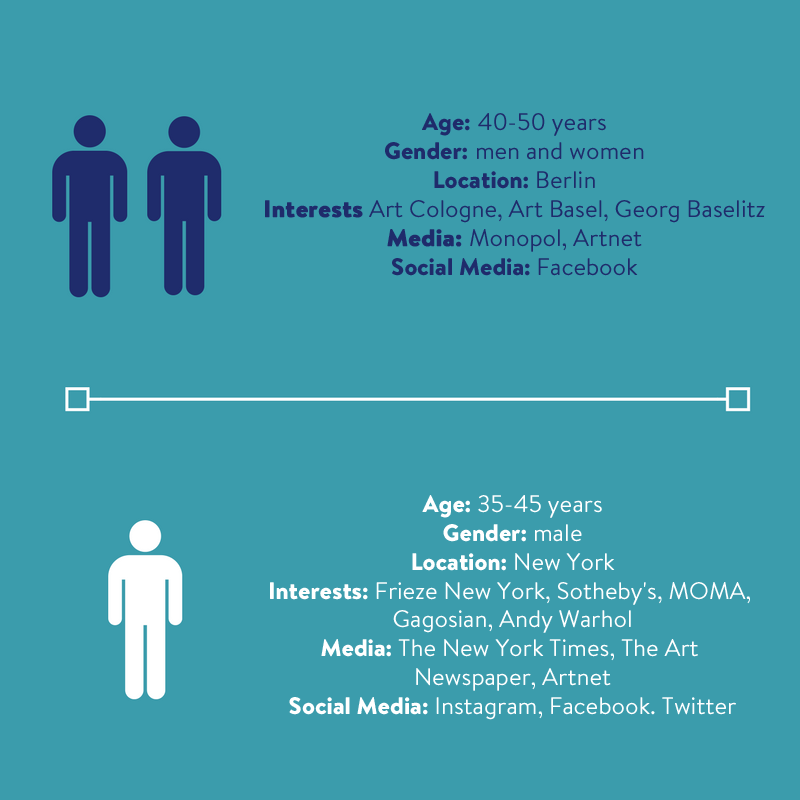
Top 5 online marketing tips for galleries
Every gallery is also a commercial enterprise that needs to sell its art and find new collectors. Today, a number of tools and channels exist that allow you to promote your gallery and your artists and to attract potential collectors and art lovers. In our five tips and specific examples, we’ll show you how to bring more visitors to your website, how to raise your artists’ profile, and how to sell more art using simple and inexpensive measures.
Tip 1: Set Your Goals
Before applying online marketing strategies to boost your gallery, make sure you define specific objectives you’d like to achieve. You’ll then find it much easier to determine necessary marketing measures.
Would you like to:
- Attract more visitors to your gallery’s website or reach out to new collectors?
- Raise your artists’ profile?
- Sell more art?
- Motivate existing clients and collectors?
If you’re having trouble defining your goal, ask yourself the following questions:
- Are only a few people visiting your website, even though you own a great site through which you’ve already managed to make new contacts and generate sales?
- Does your gallery programme feature many aspiring but still unknown artists?
- Do you have many clients who purchased art works once or twice and did not return?
- Did you expand your programme and are now looking for new collectors?
Once you’ve established your personal goal, you’ll need to determine your audience.
Tip 2: Find Your Audience
Your goal, which you’ve already defined in the first step, will determine your audience. If you know who you want to reach (e.g. collectors within your environment or international contacts from a certain country), try to find out as much as you can about your target audience:
- Where can I find my audience?
Are you frequently visiting art fairs and exhibitions, or do you prefer to find new art online? - Which media and social media channels does my audience use?
Use the same channels as your audience. - Where does my audience live?
Are you selling local artists to local collectors? In that case, you’ll find your audience in your area. - What’s my audience’s average age?
Which artists and issues does this age group favour? - What does my audience like?
Make use of your audience’s interests to advertise within your preferred media or to define a target group for Facebook Ads.
The more detailed you analyse your target audience, the better you can address them (e.g. on your website, through social media channels, by advertising). You may find information on potential clients in Google-Analytics, your gallery’s Facebook Statistics, Client Surveys, or Reports on existing clients drawn from your art database software.

Tip 3: Optimise Your Website
To attract your target group, it’s important to optimise your own website in order to reach a high rank in search engines on the search result page. For art lovers, your gallery’s website will often serve as the first point of contact with your art. Use this first opportunity for reaching out and sparking interest in your art. The following criteria will help you optimise your website so that it will appear among the first 10 search results:
- Offer visitors interesting, relevant, and up-to-date information on your gallery, artists, and events.
- Gallery websites depend on good and high-res images. Allow your visitors to view more details and zoom into images! Ideal are image sizes between 1000-3000 pixels.
- Include relevant links to artists’ websites, online shops, your social media profiles, and more.
Make sure to also use key words in your link text: “Find out more about the exhibition opening by [artist name]”
- Your texts should include relevant key words for appropriate search results.
Your gallery’s name, your most important artists, as well as aspects of your programme (e.g. post-war art, contemporary art, art from Asia, etc.) are among the most important references.
- Make sure visitors can view your website on smartphones and tablets problem-free.
Up to 20-30% of online visitors view websites over smartphones and tablets (customer’s survey results 2017), and even Google loves Responsive Websites which you can easily set up with our ARTBUTLER Websites.
This is not about your gallery turning into an e-commerce company—think about it as part of your marketing strategy, and sales will follow (both offline and online).(Anders Petterson, ArtTactic Founder & Managing Director)
Tip 4: Distribute Newsletter
Newsletters are an efficient marketing channel that allow you to reach many art lovers and clients all at once. To make sure your newsletters will be read, keep the following points in mind:
- Choose a relevant and interesting topic for your readers:
Which exhibition openings are of interest to which clients and collectors? Who is interested in one of your artists? Who will you most likely meet at the next art fair? - Specify a benefit for your readers in the subject line. Why should they read your newsletter? Example: “Are you going zo Art Basel?”, “[artist name] featured in new exhibition”. For a subject line that works, enter up to 50 characters.
- Address your readers as personally as possible. Include your contact names if you have them or refer to the last customer contact.
Example: Dear Joe Bloggs, in our last meeting we discussed new works by [artist], which are available in our new exhibition [title] from [date]. I look fward to seeing you there! - Include links to further information: your website, your artists, exhibitions, or Facebook Events. You may also link to your social media channels in your newsletters.
- Find the right moment:
When is your target audience mist likely working on their computer? Consider different time zones in which readers will receive your newsletter.
If you’re using Rapindmail, MailChimp, or another newsletter tool, it’ll be easy to evaluate your campaign’s success. View opening and click figures after each dispatch and try to find causal links. This will allow you to improve your newsletters and discover what works best for your audience(s).
Tip 5: Use Social Media
Social Media is an integral part of any online marketing strategy, offering a multitude of possibilities to boost your image. Start with the most essential:
By the way: Find out the advantages of social media for galleries.
- Create your own profile to share your news
- E.g. art fair participation, artists’ awards and accolades, published interviews, new art works and artists, and more.
- Make use of various communication methods to offer viewers glimpses behind the scenes of your gallery, to present art fair and exhibition installations, or to interview visitors or artists live and on-site.
- Link to your artists via @name, or to other media and relevant persons using corresponding hashtags (e.g. #ArtFair, #ContemporaryArt, #painting, #sculpture or #Basel) to reach a wider audience.


- Create Facebook Events
- For your exhibitions or share an exhibition announcement featured on your website on social media.
- Use Facebook Ads
- You may promote exhibitions, special offers, new art works, and more.
- Keep potential clients in mind: exhibitions in Berlin are only interesting to your audience in Berlin and its surroundings. If you are participating in Frieze New York, however, create ads that reach art enthusiasts located in America or New York.

When creating marketing strategies, it’s essential that you first carefully consider what you wish to achieve, and who you want to address. Use as many channels as possible (marketing mix) to reach as many potential and actual clients as possible. Always consider the resources you’ll need to achieve your goals: do you have enough staff to take care of marketing and communication? How high is your budget for Facebook Ads or newsletters? Be bold and experiment with different marketing strategies, and be persistent! Over time, you’ll learn what works best for you and your target audience. Don’t hesitate and start today!